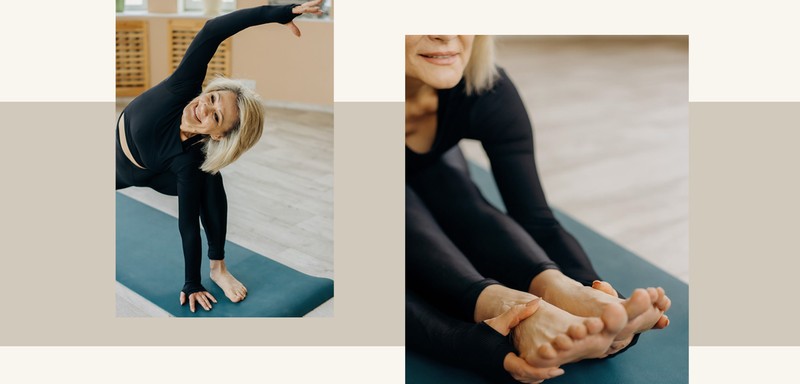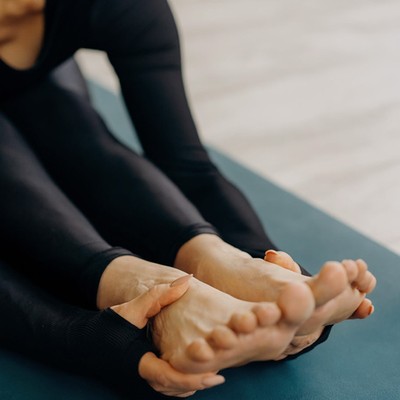

How To Stay In Shape As You Age

Menopause changes how the body works. Women lose, on average, half a pound of muscle each year from our thirties. This doesn’t just mean muscle strength; this also refers to a loss of protein and collagen from the body. By the time you reach 50, you’ll have lost around ten pounds of lean tissue, which is why strength training is imperative as you age. And no, lifting weights won’t make you bulky, and this is especially true later in life. If you start strength training when you’re 50, you’re actually recovering muscle that has been lost over the years and this will build strong, healthy bones, too. As you slowly increase body strength, you’ll also build lean muscle mass in your organs – you’ll build lean muscle in your heart, thyroid and ovaries. If you don’t lift weights, then it’s no wonder we struggle with hormonal imbalances later in life.
Many women still fixate on cardio. Cardio literally means ‘heart’ or ‘circulation’, and there are countless ways to raise your heart rate that don’t involve running on the treadmill. Lifting weights can absolutely be a form of cardio. Many women still think that more is better when it comes to fitness, but when you train for too long, especially long cardio sessions, your body eats into muscle and it wastes away, cortisol levels skyrocket and insulin (i.e., sugar) is pumped into the muscles to keep you going. Without getting too scientific, you can end up depleting the very tissue you’re trying to build. Plus, calcium binds with protein in the bones, so when you eat into your muscles, you’re eating into the body’s reserves, depleting calcium, and your bones, too.
High intensity interval training can work for you. HIIT can mean burpees, push-ups and pushing yourself till you’re on your knees, but that isn’t how you’ll get results, especially post-50. A 20-minute HIIT workout is plenty, and the best thing is there’s no set formula. If you’re a total beginner, start on a gym bike – cycle for 20 minutes and incorporate the odd 30 second sprint, pushing yourself harder to the point where you’re out of breath. Cycling is also fantastic for your knees as you age. If you’re a runner, add in a couple of ten, 20 or 30-second sprints, resting for 30 seconds and then repeating a few times – you can try this method in the pool, too, if you enjoy swimming. Just five or ten minutes of this form of interval training makes a difference. HIIT doesn’t have to be high intensity – it’s about what works for you. I’ve lost count of the number of times I’ve seen women jump into a HIIT class and injure themselves. Burpees and jumps can be dangerous if your glutes and hamstrings aren’t engaged – this is what leads to pulled knees and back problems.
Lifting weights is essential for a stronger body. When you lift a heavy weight, your whole body engages and it kickstarts levels of growth hormone, which counteracts insulin levels, helping you burn fat. Light weights, which are often used in barre and Pilates, are great for stabilising and isolating small muscle groups but, for real results, you need to lift heavy weights. Find a weight that is challenging for you – you should aim to do six to eight reps with a weight, with the final two reps being very challenging to complete. This ultimately means you’ll be able to complete a fantastic, results-driven workout in 15 to 20 minutes, as opposed to a less efficient 40-minute workout.
Gym machines are a great way to start using weights. Head to your local gym and ask one of the trainers on the gym floor to show you the best and most effective machines and to give you a simple programme. You’ll be surprised how straightforward they are to use and how quickly you’ll improve. Start with the heaviest weight you can lift and then lighten it each set as you move through your workout. After the first couple of sessions, you may feel sore, but you will see results quickly. Resistance bands are also great if you struggle with aches and pains in your joints. If you struggle with sore knees, a tight back or cranky hips, nine times out of ten the ache has nothing to do with this specific area but everything to do with the muscles surrounding them not being strong enough to hold and support you.
Three workouts a week is plenty. If you’re training efficiently and making the most out of a session, three 20-minute workouts a week is great. Don’t train more than four times a week as your body won’t recover properly and it could ultimately affect energy levels. The exception to this is walking, which is a fantastic way to recover, aid circulation and get blood and oxygen flowing.
Stretching is overrated. If you’re training frequently, then you don’t need to worry about generic post-workout stretches. If you train properly, you’ll be stretching as part of your workout without realising – for example, when you squat, you’re boosting circulation and stretching around your quads, hamstrings and calves. If you’re just starting out on your fitness journey, you may need to stretch a little more to open things out, but if your body is working as it should, you shouldn’t need to stretch.
Whatever your fitness goals, you should prioritise sleep. I look for three things with my clients, regardless of what they are looking to achieve – sleep, energy and stress levels. In an ideal world, your energy levels and sleep would be as close to nine out of ten on a daily basis, and your stress levels down to one or two out of ten. When you sleep, a resetting process takes place – your body recovers and replenishes itself. If you don’t sleep well, your sugar levels will be higher in the morning, you’re more likely to gain fat from the food you eat that day and you’re far more likely to crave sugary foods. When you get a good night’s sleep, processes happen in the body that mimic the effects of HIIT training – deep sleep kickstarts the release of growth hormone, which repairs muscle and strengthens bone.
When you reach your fifties, fat is more essential than ever. You need fat to make hormones, meaning a low-fat diet is a terrible idea post-menopause when hormones can be all over the place. In the post-menopausal years, oestrogen levels drop and we tend to become more insulin resistant, which means you’re more likely to gain fat around the stomach. The only food that doesn’t cause the body to release insulin is fat. We also need fat to absorb fat-soluble vitamins – such as vitamins A, D and K – many of which are involved in antioxidant support, bone growth and hormone production, too. The quality and the freshness of your fat matters – buy the best and freshest forms you can afford. Keep nuts in the fridge to maintain their healthy fats, buy grass-fed butter and cook with quality olive oil and coconut oil.
Avoid eating for an hour either side of a workout. If there’s minimal amounts of sugar in the bloodstream immediately before or after exercise, this causes a surge in growth hormone, which pushes protein back into the muscles and bones. Don’t get hung up on the best foods to eat before a workout and get comfortable with gentle intermittent fasting, which helps stabilise insulin levels and gives your hormones a chance to reset.
Magnesium is a great all-round supplement. Sleep is often the biggest challenge for women in their fifties and beyond, and this can have a knock-on effect in so many areas. In the menopausal years, your magnesium needs increase, so it makes sense to top up with a supplement. Plus, magnesium also aids calcium absorption and helps regulate melatonin, the sleep hormone. Strong Nutrients’ Magnesium Rocks is my go-to. It also works well paired with Chill Pill, an adrenal support formula that helps the body relax.
Amino acids can help balance hormones and burn fat while you sleep. Through the years as a PT, I’ve always been interested in one particular amino acid (the building blocks of protein), l-ornithine. Studies show it supports natural growth hormone release during exercise as well as sleep. By counteracting the effects of insulin, growth hormone has been found to support fat loss, in particular belly fat. For the best results from Amino Slim – one of the bestselling supplements in the Strong Nutrients range – take before bed, or 30 minutes before exercise, ideally having fasted for two-and-a-half-hours beforehand. Also consider adding creatine to your routine, which improves strength and stamina, which in turn will allow you to train harder and build muscle more effectively.
For more information or to book a session with Zana, visit ZanaMorris.com. Her supplement range, Strong Nutrients, is available at StrongNutrients.com
DISCLAIMER: Features published by SheerLuxe are not intended to treat, diagnose, cure or prevent any disease. Always seek the advice of your GP or another qualified healthcare provider for any questions you have regarding a medical condition, and before undertaking any diet, exercise or other health-related programme.
DISCLAIMER: We endeavour to always credit the correct original source of every image we use. If you think a credit may be incorrect, please contact us at info@sheerluxe.com.

